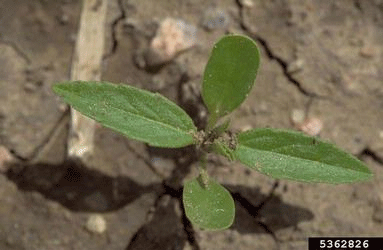Some Extension clients reached out during late summer and early fall with questions about toothed spurge (Euphorbia dentata) in their fields. This unique plant is in the spurge family (Euphorbiaceae), the same family as the invasive leafy spurge and poinsettias. The plant is sometimes called green poinsettia or summer poinsettia. The common name ‘spurge’ is believed to come from the Latin for ‘purge,’ referring to the ill effects plants in the family have on digestive systems. Plants in the spurge family produce a milky sap when any plant part is broken. The sap can irritate the skin and eyes.
Ecology
Toothed spurge is a summer annual plant distributed across the United States from New York to Arizona. It is believed to be native to the United States. It is typically found in pastures, hayfields, roadsides, and other non-crop areas. It can be found in both wet and dry sites.
Identification
Toothed spurge grows upright and reaches heights between 8 and 24 inches. The round stem is hairy and can be reddish when growing in bright light.
Leaves are oppositely arranged (Figure 1). They are lanceolate and approximately 1/2 to 3 inches long with toothed margins. They usually have hairs and often have one or more dark red spots on the upper surface, especially with age (Figure 2). Lower leaves may sometimes be alternately arranged. Leaves at the ends of stems near the flowers often appear whorled.

Figure 1. Red spots on lanceolate leaves surrounding light green fruits. Photo by Kevin Bradley, University of Missouri.

Figure 2. Toothed spurge seedling. Image by Phil Westra, from Bugwood.org
Inconspicuous, white/yellow flowers without petals are found in clusters at the ends of branches. Three seeds form in a smooth, yellowish-green capsule. Seeds are dark brown/black ovals about 1/8 inch long.
Management
There is some evidence that toothed spurge is more prominent in tilled fields than in no-till fields. It is relatively tolerant of glyphosate and Group 15 herbicides like S-metolachlor (Dual, others), acetochlor (Harness, others), and dimethenamid-P (Outlook). However, dicamba, atrazine, metribuzin, and flumioxazin (Valor, others) will control this weed.
The use of trade names is for clarity to readers and does not imply endorsement of a particular product, nor does exclusion imply non-approval. Always consult the herbicide label for the most current use requirements.
Sarah Lancaster, Extension Weed Management Specialist
slancaster@ksu.edu
Tags: World of Weeds toothed spurge